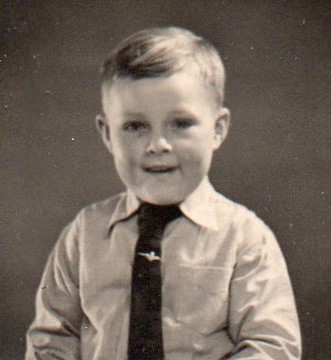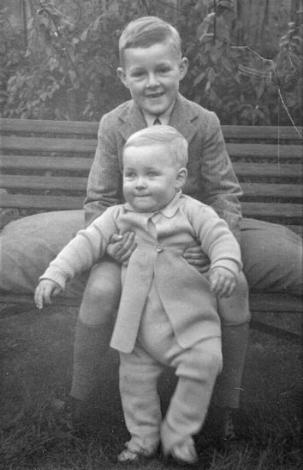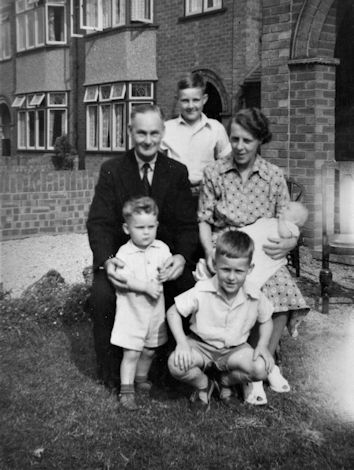Christopher Kite
May 2020
On the 75th Anniversary of VE Day, Chris Kite had these recollections of local celebrations on VE Day and the subsequent Children’s Victory Party. Chris has also added further details about growing up in Trumpington.

VE Day, 8 May 1945, and Street Party, 14 June 1945
I was born at 10 Bishop’s Road, Trumpington, in December 1938, and my family moved away in 1951. In World War 2, I remember there was a circular brick walled tank containing water (and rubbish) for fire fighting, immediately on the right as you turned into the road on waste ground before you came to Mrs Richardson’s shop, a bungalow on the end of the row of houses on that side [Mrs Richardson’s general store, 4 Bishop’s Road, later the Dental Surgery]. A track led down beside the shop to a house on its own at the back of the row of houses. In front of this was a group of sheds rented out and used as garages or workshops. Between them and the railway line to Bedford was more waste land, which local children played on.
For VE night on 8th May 1945, a huge bonfire miraculously appeared during the day. It was built out of tree branches, cardboard and wood from packing cases, together with discarded household and garden waste, etc. That evening, residents from the locality danced and sang, chatted and joked well into the evening round the lit fire. There were even some fireworks, kept by “Richie” [Mrs Richardson] at the shop from before the War and brought out for the occasion! I had never seen people so happy! No doubt there were a few beers and other “liquid refreshments” as well. I do not remember much food in evidence, except for plenty of baked potatoes cooked in embers raked out from the fire.
Some days later [14 June 1945], Maris Lane was closed off and a set of tables and chairs put out for a street party for the children of the village. The trestle tables were erected along the road, positioned outside Maris House and the side entrance to Anstey Hall. I remember the spot for another reason, there was a low outbuilding next to the house and I once lost my school cap up on its roof, thanks to the exuberance of school friend, Peter. He was the son of the village bobby and he got it in the neck for his trouble. It was close to the village school at the end of the road, you see, where we attended, taught by Mr Youngs [the School Master, Eric George Youngs] and later also by an elderly lady (well she seemed elderly), Miss Lister. I remember the occasion of the street party all seemed very colourful, with bunting, table cloths, coloured fizzy pop, etc. I do not remember what we had to eat exactly, but I think some hoarded corned beef and spam featured in the sandwiches, with home-made chutneys together with scones and jam, fruit jelly and, of course, a piece of cake! Because of rationing and shortages, it may not have compared too well with modern party fare, but to us youngsters it was a feast!
There is further information about the Children’s Party in the World War 2 notes (July 1945 items).
Additional memories
My parents were George and Winifred Kite. During World War 1, my father served from 1917 in the Royal Naval Air Service as navigator, gunner and bombardier flying over the Channel in DH4s on anti-submarine patrol. He then transferred to the RAF in 1918. During World War 2, he re-joined the RAF and served in 206 Squadron Coastal Command at RAF Bircham Newton, Norfolk. He was first trained in fire and rescue and then went into aircraft maintenance on Lockheed Hudson aircraft before ending up in the stores. During the latter stages of his service he was suffering badly from eczema and was discharged before the end of the War. My father died in 1952 from cancer and my mother died in 2002. They had four children and we are all still going strong, including Peter who lives in Massachusetts, USA.
My parents had moved to Cambridge from the Kent part of Greater London shortly before the War, and then some six months into the War, bought a newly completed house, 11 Bishop’s Road, opposite their original home at 10 Bishop’s Road.


The 133 Eastern Counties bus used to turn into Bishop’s Road to drop off its passengers before returning to Drummer Street. One day there was a loud bang as a vehicle collided with the bus as it turned; my mother was on board at the time but no one was hurt, only shaken up.
My mother told me she found attitudes in the village very old-fashioned before the war. She was waiting to be served in the Post Office when a car drew up and Mrs Pemberton from Trumpington Hall swept in. She was apparently accustomed to going straight to the head of the queue. Traditionally many would have been tenants or the men worked for them. However, on this day she was disconcerted to find that not all of those in Post Office felt obliged to show her that degree of deference! However the Pemberton family was good to the village, allowing free use of their park for recreation and opening the Hall garden each year for the village fête. One year I unwisely slid down a sloping support for a wooden post in their vegetable garden, collecting a seat full of splinters in the process!
I walked to Byron’s Pool many times and can remember the loud cawing of the rooks in tall trees near the bridge. On one occasion at least, several families from Bishop’s Road picnicked together beside the river, in a field just past the bridge on the right hand side, part of Grantchester Meadows I think. Efforts to play cricket were spoiled by the abundance of cowpats! In the spring of 1947, the whole area of road and fields beyond the bridge was flooded all the way to Grantchester mill.
I went to Sunday School in Trumpington. I still have a bible awarded for bible knowledge and a copy of the Apocrypha signed by the vicar, T. Young, for my time at Sunday School. More exciting was the annual outing to Felixstowe in a succession of single decker buses, with the highlight of eating fish and chips in the Trent’s Café on the seafront. The story was that the vicar and Mrs Young had friends in Felixstowe who they used to visit – certainly they never came on to the beach with the children for long. I remember reading one of the lessons at the Christmas service of Nine Lessons and Carols, standing on a box to see the bible. I was in the Wolf Cubs and the Boy Scouts (44th Cambridge). In those days, the scouts wore the traditional Mounties’ broad brimmed and pointed felt hat and our scarf was brown with a vertical stripe of blue down the centre of the point at the back. A favourite game was ‘bulldog’ and we had chariot racing in the park of Trumpington Hall using staves lashed together to make an ‘A’ frame. The cubs used to meet in the old bakehouse next to the church. The Akela lived at a public house on the main road, the Green Man, I think, near the top of Church Lane. I made my first 2d phone call to her from the red telephone box nearly opposite the top of Maris Lane. There was a police box close by and an AA box on the cemetery corner. I was senior sixer during my last year in the cubs and carried the pack flag in church parades and at the remembrance service at the War Memorial at the top of Church Lane. We processed behind the vicar, who was wearing a black cloak over his surplice and a mortar board, from the school to the cross for the service which the school children all attended, which was always held on 11th November.
I went on from the village school to the Central School on Parker’s Piece in 1949, for two years, before we moved away. My brother Peter was a pupil at Fawcett School when it opened; Mr Youngs transferred there as the head teacher. I was always envious of the boys in the village school who went off in the afternoons regularly to be taught how to grow vegetables and who showed off their produce of carrots and radishes. I had to stay in the classroom with those others in the class who were more studious. All was not lost, however, as our next door neighbour, Mr Curtis, took me to where he worked at the Plant Breeding Institute in the grounds of Anstey Hall (Maris Piper potatoes were developed there) to show me how he prepared an asparagus bed. Unfortunately, I have never put his instruction to good use.
I was delighted to read David Stubbings’s account of growing up in Trumpington and his later experiences working on Tebbit’s farm [Glebe Farm]. I recall we ‘helped’ with the harvest one year in particular and were rewarded by a ride back to the farm yard on the horse-drawn hay wagon. He was a neighbour in Bishop’s Road and a close pal; we spent a lot of time together at that time. We used to roam the fields following Hobson’s Brook and over towards Nine Wells where the Italian POWs were working in the fields. We had our portraits drawn by one of them for about ten bob each. David’s was very good. Sadly my mother was not at all impressed with mine and it has long since disappeared!
We used to watch the steam trains chuff past on the main railway line, with their endless procession of coal wagons. It may have been the railway that the German daylight raid was aiming for when the bomb was dropped on Cambridge. I remember we had been sitting round our steel Morrison shelter, which served as a dining table, when there came the crump and rattle of the bomb going off early one afternoon. I was pretty young at the time but it took everyone by surprise and I remember the consternation of my parents and the two land army girls billeted in the house. My other ‘brush with the enemy’ was at the end of the war when I had learned to ride a two wheeled bike. I was riding across the junction of Shelford Road and Hauxton Road when I saw a column of POWs matching from the High Street towards the camp. These POWs were unusual! They were dressed in unfamiliar green-grey uniforms not the customary brown ones of the Italians. They were Germans. I was so busy ‘gawping’ that I misjudged the turn and next minute was sprawled in the gutter. Two or three of the POWs made to leave the ranks to come to help me; but the British soldier escort armed with pickaxe handles, and one at the back with a rifle, ushered them back into line and they marched on, leaving me to fend for myself!
One other memory: Maris Lane – or rather the buildings on either side – was the site of a colony of house martins in those days, I wonder if they are still there?